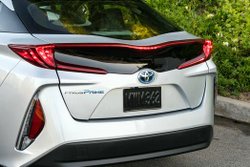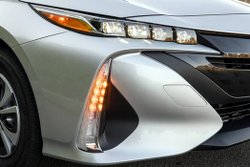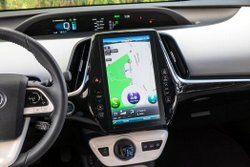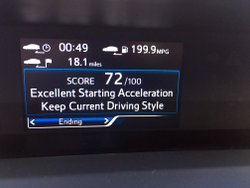Update to a Classic Plug-in
As “Kleenex” is to tissues, or “Google” is to search engines, “Prius” is to hybrid cars. It’s surprising that “priusing” hasn’t become a verb for “driving efficiently.”

The original Prius had an engine and an electric motor sharing duties to extend the range and efficiency of the gas engine. Braking regenerated the electricity for the small electric motor. Then, about five years ago, Toyota introduced the plug-in hybrid, which permitted limited all-electric driving, but the EV range was small—about 11 miles. Other manufacturers have since offered cars with a greater range.
So, when the Prius was reimagined for its latest version, not only did the stylists go crazy with the design, they upgraded the plug-in version. Today, renamed the Prius Prime, Toyota’s plug-in hybrid can go up to 25 miles in all-EV mode.
That significantly bigger number is the key to getting real value out of a plug-in hybrid. With the 2017 Toyota Prius Prime, I could drive 18 miles to work on a charge, fill the battery back up there, and head home equally gas free. Charging time from empty is about 5 1/2 hours on standard household current or just two hours on a Level 2 240-volt charger, such as the ChargePoint system at my office.
Where a Plug-in Hybrid Shines
Where a plug-in really shines (compared to a pure electric car) is when you want to go on a longer trip. I tried this out with a 170-mile round trip to visit my grandkids. We cruised along on electrons until the car switched to hybrid mode and then it swapped power sources the rest of the way. We plugged in at our destination and reclaimed some pure EV miles for the trip home.
The Hybrid Synergy Drive System mates a 1.8-liter four-cylinder gas engine with two electric motors for a total of 121 horsepower. The 8.8 kilowatt-Hour lithium-ion battery pack, more than double that of the previous plug-in, hides beneath the cargo area, leaving 19.8 cubic feet of cargo capacity.

The official EPA numbers are 54 mpg without plugging in. When you do charge up the car, you can get up to 133 MPGe (EPA’s miles per gallon of gasoline-equivalent, which measures the energy content of electricity used per mile), which ranks tops in the world of plug-in hybrid cars. You’ll get a nice 8 for Smog and perfect 10 for Greenhouse Gas in the EPA green ratings, too.
For my week, I averaged 70.5 miles per gallon–a truly wonderful achievement. The car, with about 5,000 miles on it, showed an overall average of 100.6 mpg—likely from a lot of electric driving.
Quiet but Loudly Styled
The 2017 Toyota Prius Prime rolls along about as silently as you’d expect in EV mode—and it’s not a whole lot louder in hybrid mode. Extra insulation keeps road and wind noise out.

You can select from three trim levels—Plus, Premium, and Advanced. My Magnetic Gray Metallic tester was the Advanced, so it came with a long list of features for efficiency, comfort and enjoyment. See Toyota’s website or visit your dealer to study the details.
The Prime’s styling is significantly different and perhaps a bit more aesthetically pleasing than the regular hybrid’s. The nose gets a sparkling row of LED headlamps that come with automatic dimming and features two massive grilles at the lower corners that mimic to the look of its hydrogen-powered Mirai brandmate. The rear swaps the regular Prius’ bizarre vertical taillamps for more integrated horizontal ones, and adds a friendly wave to the rear glass and hatch panel. Still quirky, but undeniably a Prius all the way.
Tech Inside
Inside, the center-mounted instrument panel controls appear to float above the dash. Most notable is the new 11.5-inch vertical display, which borrows from the Tesla design school.

There’s a wealth of information displayed, from navigation to audio selections from the Entune system to loads of data on the environmental performance of this decidedly high-tech ride.
Ignoring the massive screen, essential data is all tucked into the slim center strip just below the windshield. Ironically, the colored head-up display repeats some information right above it.
The seats, in Softex artificial leather, were comfortable for hours of travel, and the black-and-white ambiance of the interior proved restful and easy to live with.
Pricing and Value
As overall vehicle prices rise, hybrids don’t seem so expensive anymore. The 2017 Toyota Prime Plus starts at $27,965, the Premium at $29,665, and the Advanced at $33,965, including shipping. My tester had seven extra items, including a universal tablet holder, wheel locks, illuminated door sills, paint protection film and a glass breakage sensor, and hit $36,305.

While I believe that pure electric vehicles are wonderful, if you live a daily life that combines moderate weekday commuting with occasional longer trips, the 2017 Toyota Prius Prime may be the ticket. You do have to live with the weird looks, but with up to 640 miles of range and gas power backup, travel opportunities are limitless.
Related Stories You Might Enjoy:
Road Test: 2017 Toyota Prius Prime (Larry’s view)
Road Test: 2017 Toyota Prius Prime (John’s view)
Comparison Test: 2017 Kia Optima Hybrid & Plug-in Hybrid
Road Test: 2017 Ford Fusion Energi
Road Test: 2016 Chevrolet Volt
Road Test: 2017 Hyundai Sonata Plug-in Hybrid
Disclosure:
Clean Fleet Report is loaned free test vehicles from automakers to evaluate, typically for a week at a time. Our road tests are based on this one-week drive of a new vehicle. Because of this we don’t address issues such as long-term reliability or total cost of ownership. In addition we are often invited to manufacturer events highlighting new vehicles or technology. As part of these events we may be offered free transportation, lodging or meals. We do our best to present our unvarnished evaluations of vehicles and news irrespective of these inducements.
Our focus is on vehicles that offer the best fuel economy in their class, which leads us to emphasize electric cars, plug-in hybrids, hybrids and diesels. We also feature those efficient gas-powered vehicles that are among the top mpg vehicles in their class. In addition, we aim to offer reviews and news on advanced technology and the alternative fuel vehicle market. We welcome any feedback from vehicle owners and are dedicated to providing a forum for alternative viewpoints. Please let us know your views at publisher@cleanfleetreport.com.

6 thoughts on “Road Test: 2017 Toyota Prius Prime”